Wingsuit flying
.jpg)
Wingsuit flying (or wingsuiting) is the sport of gliding through the air using a wingsuit which adds surface area to the human body to enable a significant increase in lift. The modern wingsuit, first developed in the late 1990s, creates a surface area with fabric between the legs and under the arms. Wingsuits are sometimes referred to as "birdman suits" (after the makers of the first commercially available wingsuit), "flying squirrel suits" (due to their resemblance to the animal), and "bat suits" (due to their resemblance to the animal or perhaps the superhero).
A wingsuit flight normally ends by deploying a parachute, and so a wingsuit can be safely flown from any point that provides sufficient altitude for flight and parachute deployment—normally a skydiving drop aircraft, or BASE-jump exit point. The wingsuit flier wears parachute equipment specially designed for skydiving or BASE jumping. While the parachute flight is normal, the canopy pilot typically unzips arm wings (after deployment) to be able to reach the steering parachute toggles and control the descent path.
History
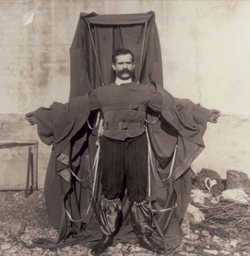
An early attempt at wingsuit flying was made on 4 February 1912 by a 33-year-old tailor, Franz Reichelt, who jumped from the Eiffel Tower to test his invention of a combination of parachute and wing, which was similar to modern wingsuits. He misled the guards by saying that the experiment was going to be conducted with a dummy. He hesitated quite a long time before he jumped, and was killed when he hit the ground head first, opening a measurable hole in the frozen ground.[1]
A wingsuit was first used in 1930 by a 19-year-old American, Rex Finney of Los Angeles, California, as an attempt to increase horizontal movement and maneuverability during a parachute jump.[2][3] These early wingsuits were made of materials such as canvas, wood, silk, steel, and whalebone. They were not very reliable, although some "birdmen", notably Clem Sohn and Leo Valentin, claimed to have glided for miles.
In the mid-1990s, the modern wingsuit was developed by Patrick de Gayardon of France, adapted from the model used by John Carta. In 1997, the Bulgarian Sammy Popov designed and built a wingsuit which had a larger wing between the legs and longer wings on the arms. His prototype was developed at Boulder City, Nevada. Testing was conducted in a vertical wind tunnel in Las Vegas at Flyaway Las Vegas. Popov's wingsuit first flew in October 1998 over Jean, Nevada, but it never went into commercial production. Popov's design was a great improvement in creating lift; it was able to slow the vertical speed to 30 km/h while gliding horizontally at speeds over 300 km/h. In 1998, Chuck "Da Kine" Raggs built a version which incorporated hard ribs inside the wing airfoils. Although these more rigid wings were better able to keep their shape in flight, this made the wingsuit heavier and more difficult to fly. Raggs' design also never went into commercial production. Flying together for the first time, Popov and Raggs showcased their designs side-by-side at the World Free-fall Convention at Quincy, Illinois, in August 1999. Both designs performed well. At the same event, multiple-formation wingsuit skydives were made which included de Gayardon's, Popov's, and Raggs' suits.
Commercial era
In 1999, Jari Kuosma of Finland and Robert Pečnik of Croatia teamed up to create a wingsuit that was safe and accessible to all skydivers. Kuosma established Bird-Man International Ltd. the same year. BirdMan's "Classic", designed by Pečnik, was the first wingsuit offered to the general skydiving public. BirdMan was the first manufacturer to advocate the safe use of wingsuits by creating an instructor program. Created by Kuosma, the instructor program's aim was to remove the stigma that wingsuits were dangerous and to provide wingsuit beginners (generally, skydivers with a minimum of 200 jumps) with a way to safely enjoy what was once considered the most dangerous feat in the skydiving world. With the help of Birdman instructors Scott Campos, Chuck Blue and Kim Griffin, a standardized program of instruction was developed that prepared instructors.[4] Wingsuit manufacturers Squirrel Wingsuits, TonySuits Wingsuits, Phoenix-Fly, Fly Your Body, and Nitro Rigging have also instituted coach training programs.
Despite the training and regulation, wingsuit BASE jumping remains a precarious pastime. A 2012 University of Colorado study found that for Wingsuit BASE jumping there was approximately one severe injury for every 500 jumps undertaken.[5]
Technical mechanics
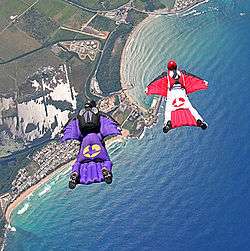
The wingsuit flier enters free fall wearing both a wingsuit and parachute equipment. Exiting an aircraft in a wingsuit requires skilled techniques that differ depending on the location and size of the aircraft door. These techniques include the orientation relative to the aircraft and the airflow while exiting, and the way in which fliers spread their legs and arms at the proper time so as not to hit the aircraft or become unstable. The wingsuit immediately starts to fly upon exiting the aircraft in the relative wind generated by the forward speed of the aircraft. Exiting from a BASE jumping site, such as a cliff, or exiting from a helicopter, a paraglider, or a hot air balloon, is fundamentally different from exiting a moving aircraft, as the initial airspeed upon exit is absent. In these situations, a vertical drop using the forces of gravity to accelerate is required to generate the airspeed that the wingsuit then converts to lift.
At a planned altitude above the ground in which a skydiver or BASE jumper typically deploys the parachute, wingsuit fliers will also deploy their parachutes. The parachute is flown to a controlled landing at the desired landing spot using typical skydiving or BASE jumping techniques.
A wingsuit modifies the body area exposed to wind to increase the desired amount of lift with respect to drag generated by the body. An attainable glide ratio of some wingsuits is 2.5:1 or more.[6] This means that for every meter dropped, two and a half meters are gained moving forward. This ratio can be referred to as flight efficiency. With body shape manipulation and by choosing the design characteristics of the wingsuit, fliers can alter both their forward speed and fall rate. The pilot manipulates these flight characteristics by changing the shape of the torso, de-arching and rolling the shoulders and moving hips and knees, and by changing the angle of attack in which the wingsuit flies in the relative wind, and by the amount of tension applied to the fabric wings of the suit. The absence of a vertical stabilizing surface results in little damping around the yaw axis, so poor flying technique can result in a spin that requires active effort on the part of the skydiver to stop.
.jpg)
Wingsuit fliers can measure their performance relative to their goals with the use of free fall computers that record the amount of time they were in flight, the altitude they deployed their parachute, and the altitude they entered free fall. The fall rate speed can be calculated from this data and compared to previous flights. GPS receivers can also be used to plot and record the flight path of the suit, and when analyzed, can indicate the amount of distance flown during the flight. BASE jumpers can use landmarks on exit points, along with recorded video of their flight by ground crews, to determine their performance relative to previous flights and the flights of other BASE jumpers at the same site.
A typical skydiver's terminal velocity in belly to earth orientation ranges from 180–225 km/h (110 to 140 mph). A wingsuit can reduce these speeds dramatically. A vertical instantaneous velocity of 40 km/h (25 mph) has been recorded . However the speed at which the body advances forward through the air is still much higher (up to 100 km/h [62 mph]).
The tri-wing wingsuit has three individual ram-air wings attached under the arms and between the legs. The mono-wing wingsuit design incorporates the whole suit into one large wing.
Further developments
Wingpack
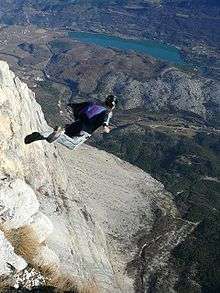
Another variation on which studies are being focused is the wingpack, which consists of a strap-on rigid wing made of carbon fibre.[7] It is a mix between a hang-glider and a wingsuit. The wingpack can reach a glide ratio of 6 and permits transportation of oxygen bottles and other material.[8]
On 31 July 2003 the Austrian Felix Baumgartner, jumping from 9 kilometres (30,000 ft), successfully crossed the English Channel in 14 minutes using a wingpack, having covered over 35 kilometres (22 mi).
In 2006, the German company ESG introduced the "Gryphon", a wingpack specifically destined for the secret incursions of the special forces.[9]
Wingsuit BASE
Since 2003,[10] many BASE jumpers have started using wingsuits, giving birth to WiSBASE. One technique is proximity flying, which is flying close to the faces and ridges of mountains. Loic Jean-Albert of France is one of the first proximity flyers, and his pioneering flying brought many BASE jumpers into the sport. In November 2012, Alexander Polli became the first WiSBASE jumper to successfully strike a wingsuit target. This target was around 3 m (10 ft) tall.
Jet-powered wingsuits
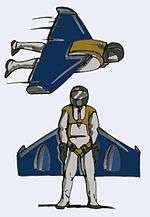
As of 2010, there have been experimental powered wingsuits, often using small jet engines strapped to the feet[11] or a wingpack setup to allow for even greater horizontal speeds and even vertical ascent.
On 25 October 2005, in Lahti, Finland, Visa Parviainen jumped from a hot air balloon in a wingsuit with two small turbojet engines attached to his feet. The engines provided approximately 160 N (16 kgf, 35 lbf) of thrust each and ran on (JET A-1) fuel. Parviainen achieved approximately 30 seconds of horizontal flight with no noticeable loss of altitude.[11][12] Parviainen continued jumping from hot air balloons and helicopters, including one for the Stunt Junkies program on Discovery Channel.[13]
Christian Stadler from Germany organized the first international wingsuit competition to feature a monetary prize, in 2005, called "SkyJester's Wings Over Marl". His "VegaV3 wingsuit system" uses an electronic adjustable hydrogen peroxide rocket.[14] The rocket provides 1000 Newtons (100 kgf) of thrust and produces no flames or poisonous fumes. His first successful powered wingsuit jump was in 2007, when he reached horizontal speeds of over 255 km/h (160 mph).[15]
Using a powered wingpack, Yves Rossy became the first person to attain the maneuverability and flight distances of an aircraft, moving only his body for steering; his experimental wingpack, however, is not commercially viable because the required construction materials are prohibitively expensive. He took an eight-minute flight over the Swiss Alps.[16]
Training
Flying a wingsuit adds considerable complexity to a skydive. According to the Skydivers' Information Manual, the United States Parachute Association (USPA) requires that any jumper flying a wingsuit for the first time have either a minimum of 200 free fall skydives made within the past 18 months and receive one-on-one instruction from an experienced wingsuit jumper, or have 500 jumps experience to attempt to fly a wingsuit without an instructor.[17] Requirements in other nations are similar. Wingsuit manufacturers offer training courses and certify instructors, and also impose the minimum jump numbers required before purchasing a wingsuit.
Records
Wingsuit formation records
Fédération Aéronautique Internationale (FAI), the world governing airsports body, established judging criteria for official world record wingsuit formations in February 2015. The rules are available on the FAI website.[18] Prior to this, the largest wingsuit formation officially recognized as meeting the criteria for a national record consisted of 68 jumpers, which set a US National Record at Lake Elsinore, California, on 12 November 2009.[19]
The largest global record was a diamond formation involving 100 jumpers at Perris, California, on 22 September 2012.[20]
Two World Records have been set since. A 42-person formation over Moorsele, Belgium, set an FAI record on 18 June 2015. This was broken on 17 October 2015, when a 61-person formation set a new FAI record over Perris Valley Airport near Perris, California.[21]
Wingsuit BASE jump records
- Highest
On 23 May 2006, the Australian couple Heather Swan and Glenn Singleman jumped from 6,604 metres (21,667 ft) off Meru Peak in India, setting a world record for highest Wisbase jump.[22] This record was broken on 5 May 2013, by the Russian Valery Rozov, who jumped from 7,220 metres (23,690 ft) on Mount Everest's North Col.[23]
- Longest
The longest verified WiSBASE jump is 7.5 kilometres (4.7 mi) by the American Dean Potter[24] on 2 November 2011. Potter jumped from the Eiger mountain and spent 3 minutes and 20 seconds in flight, descending 2,800 metres (9,200 ft) of altitude.
Wingsuit flight records
- Fastest
On 28 May 2011, Japanese wingsuit pilot Shin Ito set world records for the fastest speed reached in a wingsuit of 363 km/h (226 mph).[25]
- Longest time and highest altitude
On 20 and 21 April 2012, Colombian skydiver Jhonathan Florez set Guinness World Records in wingsuit flying. The jumps took place in La Guajira in Colombia for the following records:
- Longest time: The longest (duration) wingsuit flight was nine minutes, six seconds[26]
- Highest: The highest altitude wingsuit jump was 11,358 m (37,265 ft)[27]
- Landing
A month later, on 23 May 2012, British stuntman Gary Connery safely landed a wingsuit without deploying his parachute, landing on a crushable "runway" (landing zone) built with thousands of cardboard boxes.[28]
- Farthest
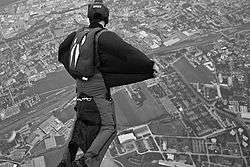
Three days later, on 26 May 2012, the Japanese wingsuit pilot Shin Ito achieved two new world records: "greatest horizontal distance flown in a wing suit", 26.9 km (16.7 mi)[29] and "greatest absolute distance flown in a wing suit", 28.707 km (17.838 mi), both flights taking place above Yolo County, California, USA.[30]
Safety
The sport of Wingsuit flying is dangerous, and the pursuit of it has contributed to a number of notable fatalities since its inception. Some fail-safe concepts and developments that using technology from airbags or Aeronautics engineering, may reduce the death rate or prevent serious injury, but it would still be one of the most dangerous sports.
In popular culture
Wingsuits were showcased in the 1969 film, The Gypsy Moths, starring Burt Lancaster and Gene Hackman.
In Lara Croft Tomb Raider: The Cradle of Life, a 2003 film, the character, Lara Croft, evades a group of henchmen by BASE jumping off of a partially finished skyscraper. The stunt was performed by the two men who developed the suits. No CGI, wires, nets, or other special effects were used.
In William Gibson's book Spook Country one of the characters is injured when BASE jumping off the Burj Kalifa tower in Dubai while wearing a wingsuit.
The wingsuit is prominently featured in the game Just Cause 3, as well as a powered version using the fictional mineral Bavarium.
Wingsuiting is one of the main features in Steep. Players can switch to and operate a wingsuit at any time, and complete challenges for wingsuiting.
References
Notes
- ↑ "Chute mortelle d'un inventeur de un parachute". Le Temps (in French). February 5, 1912. p. 4. Retrieved July 12, 2013.
- ↑ "Human Flying Squirrel Zooms Through Air". Popular Science Monthly: 53. September 1930.
- ↑ Ewers, Retta E. (January 1934). "Rex - The Human Glider". Popular Aviation (aka Flying Magazine): 28.
- ↑ "Bird-Man Worldwide Instructors list". Retrieved 28 January 2008.
- ↑ Mei-Den, Omer. "The epidemiology of severe and catastrophic injuries in BASE jumping.". PubMed. Retrieved 8 December 2014.
- ↑ "TonySuit Wingsuits - Dean Potter, record wingsuit flight - November 2011". Tony Suit Inc. 2011-11-02.
After checking out our GPS and Goggle Earth we concluded that I flew a new longest wingsuit BASE-jump to date. My flight was: 9200 feet vertical, 7.5 kilometers horizontal and approximately 3 minutes 20 seconds of flight time before opening my parachute.
- ↑ "A Modern-day Lilienthal: Alban Geissler constructs wings for people without nerves" (PDF). SPELCO GbR. Retrieved 19 May 2011.
- ↑ "Daily Mail". Daily Mail. London. 7 June 2006. Retrieved 18 May 2010.
- ↑ "Press release: ESG gives you wings – the parachute system for special operations". ESG. 15 May 2006.
- ↑ Matt Gerdes, The Great Book of BASE, BirdBrain Publishing, 2010, p. 216
- 1 2 "First jet powered Birdman flight". Dropzone.com. Retrieved 18 May 2010.
- ↑ Skydiving with rocket engines - original video of Visa's first jump. (Engineering.com)
- ↑ Animation of Visa's helicopter jump for Discovery channel's 'Stunt Junkies' show (TDMA Animation Studio website)
- ↑ "First living rocket airplane in the world! :: News by". Peroxide Propulsion. 3 January 2008. Retrieved 18 May 2010.
- ↑ "First living rocket plane in the world". YouTube. 29 September 2008. Retrieved 18 May 2010.
- ↑ Rocketman flies over alps with jet pack strapped to back, 15 May 2008 (Daily Mail)
- ↑ "U.S. Parachute Association > SIM > Read > Section 6". Uspa.org. Retrieved 18 May 2010.
- ↑ The rules are available under the Wingsuit tab on the FAI website section for parachuting: http://www.fai.org/ipc-documents
- ↑ "USPA Records: largest wingsuit formation jump". Uspa.org. 1 May 2006. Retrieved 18 May 2010.
- ↑ "Largest wingsuit formation". The Daily Telegraph. London. 22 September 2012. Retrieved 2 October 2012.
- ↑ Anonymous, "61 Wingsuit Divers Set Formation Record," discovery.com, October 21, 2015, 12:02 PM EDT.
- ↑ "Leap from the top of the world". Sydney Morning Herald. 8 June 2006. Retrieved 24 June 2012.
- ↑ Cooper, Tarquin (28 May 2013). "Valery Rozov BASE Jumps From Mt Everest". Red Bull.
- ↑ Dean Potters record breaking flight from the Eiger,
- ↑ "Fastest speed reached in a wing suit". Guinness World Records. Retrieved 10 August 2011.
- ↑ "Longest (duration) wingsuit flight". Guinness World Records.
- ↑ "Highest altitude wingsuit jump". Guinness World Records.
- ↑ Gary Connery: stuntman completes 2400ft skydive without a parachute
- ↑ "Greatest horizontal distance flown in a wing suit". Guinness World Records. Retrieved 10 August 2012.
- ↑ "Greatest absolute distance flown in a wing suit". Guinness World Records. Retrieved 10 August 2012.
Citations
Further reading
- Hickley, Matthew (7 June 2006). "Special forces to use strap-on 'Batwings'". London: Daily Mail. Retrieved 6 May 2012. External link in
|publisher=(help) - Dixon, Donna (16 April 2010). "Soldier sets wing-suit world record". Army.mil (Official U.S. Army website). Retrieved 6 May 2012.
- "Wingsuit flyer dives through hole in Chinese mountain". BBC News. 26 September 2011. Retrieved 12 May 2012. (Brief article with video).
External links
| Wikimedia Commons has media related to Wingsuit flying. |